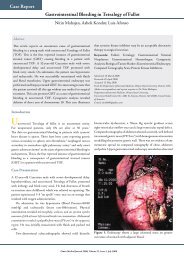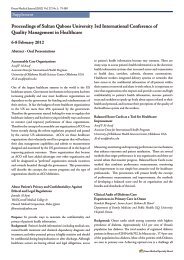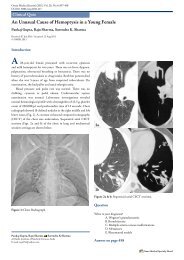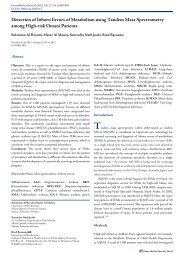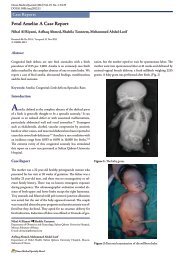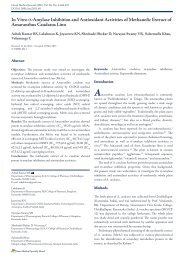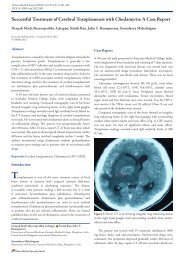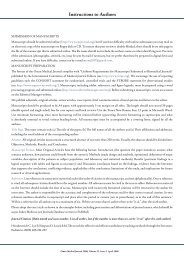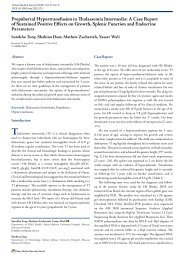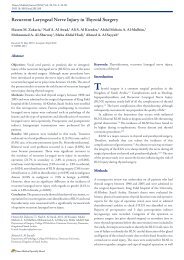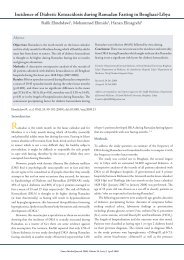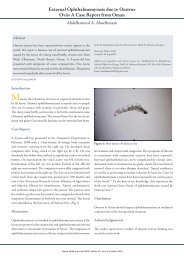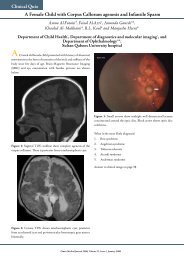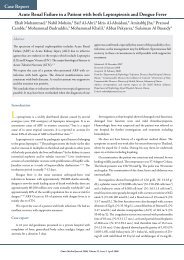Sanjad-Sakati Syndrome in Omani children - OMJ
Sanjad-Sakati Syndrome in Omani children - OMJ
Sanjad-Sakati Syndrome in Omani children - OMJ
You also want an ePaper? Increase the reach of your titles
YUMPU automatically turns print PDFs into web optimized ePapers that Google loves.
<strong>Sanjad</strong>-<strong>Sakati</strong> <strong>Syndrome</strong> <strong>in</strong> <strong>Omani</strong> <strong>children</strong><br />
Bushra Rafique and Saif Al-Yaarubi<br />
Abstract:<br />
<strong>Sanjad</strong> <strong>Sakati</strong> <strong>Syndrome</strong> is an Autosomal Recessive disorder<br />
found exclusively <strong>in</strong> people of Arabian orig<strong>in</strong>. It was first reported<br />
from the K<strong>in</strong>gdom of Saudi Arabia <strong>in</strong> 1988. This is a report of a<br />
family with this rare disease <strong>in</strong> Oman. The syndrome comprises<br />
of congenital hypoparathyroidism, severe growth retardation,<br />
low IQ and typical facial features. Supportive treatment <strong>in</strong> the<br />
form of vitam<strong>in</strong> D and growth hormone is often offered to these<br />
<strong>children</strong>.<br />
From the Department of Child Health, Sultan Qaboos University Hospital,<br />
Al Khod, Muscat, Sultanate of Oman.<br />
Received: 17 Jan 2010<br />
Accepted: 30 Mar 2010<br />
Address correspondence and repr<strong>in</strong>t request to: Dr. Saif Al-Yaarubi, Department<br />
of Child Health, Sultan Qaboos University Hospital, Al Khod, Muscat, Sultanate<br />
of Oman.<br />
E-mail: hawa34@hotmail.com<br />
doi:10.5001/omj.2010.63<br />
Introduction<br />
<strong>Sanjad</strong> <strong>Sakati</strong> syndrome (SSS) is a newly described syndrome<br />
ma<strong>in</strong>ly from the Middle East and the Arabian Gulf countries. 1-8<br />
Children affected with this condition are born IUGR and present<br />
with hypocalcaemic tetany or seizures due to hypoparatyroidism<br />
at an early stage <strong>in</strong> their lives. They have typical physical features,<br />
namely; long narrow face, deep set small eyes, beaked nose, large<br />
floppy ears and micrognathia- severe failure to succeed and mild to<br />
moderate mental retardation.<br />
started on oral calcium and alphacalcidol. Later on calcium was<br />
stopped and she ma<strong>in</strong>ta<strong>in</strong>ed her serum calcium on alphacalcidol<br />
only.<br />
Cases report<br />
Three <strong>Omani</strong> sibl<strong>in</strong>gs (two girls and one boy) presented to the<br />
Pedicatrics department at Sultan Qaboos University Hospital<br />
with SSS. The <strong>children</strong> were th<strong>in</strong> and lean with narrow faces,<br />
deep set small eyes, bowed nasal bridges, po<strong>in</strong>ted noses, large<br />
ears, long philtrum, th<strong>in</strong> lips, long taper<strong>in</strong>g f<strong>in</strong>gers, cl<strong>in</strong>odactyly,<br />
microcephaly with small hands and feet. The boy had p<strong>in</strong>oscrotal<br />
hypoplasia and short penis which was later surgically corrected,<br />
while the girls had normal genitalia. All other systems were<br />
normal.<br />
The boy had convulsions at the age of one month. Investigations<br />
showed: Low calcium - 1.5 mmol/L, High Phosphate - 2.7 mmol/L<br />
, normal Alkal<strong>in</strong>e phosphatase and Low PTH - 19 pmol/L (n=<br />
29-85). The convulsions were controlled with <strong>in</strong>travenous calcium<br />
<strong>in</strong>fusions. Later, he required calcium and one alpha Alfacalcidol<br />
to ma<strong>in</strong>ta<strong>in</strong> his calcium levels. Once his calcium was ma<strong>in</strong>ta<strong>in</strong>ed,<br />
oral calcium was withdrawn. He had convulsions at the age of 3<br />
months, 6 months and 4 years because of low calcium responded<br />
to IV calcium.<br />
Girl - 1 developed convulsions on the third day of life. Her<br />
calcium profile showed: Calcium - 1.9 mmol/L, Phosphate - 2.3<br />
mmol/L, normal Alkal<strong>in</strong>e phosphatase and PTH 1.5 pmol/L.<br />
(n=1.3 - 5.4). She responded well to calcium <strong>in</strong>fusion. She was also<br />
Figure 1: Family Pedigree<br />
Table 1: Anthropometric measurements at birth<br />
OFC Height Weight Year of birth Identification<br />
30 cm 42.5 cm 1.75 Kg 1992 Boy<br />
30 cm 46.0 cm 1.84 Kg 1999 Girl - 1<br />
28 cm 39.0 cm 1.38 Kg 2003 Girl - 2<br />
Girl – 2; She was <strong>in</strong>vestigated because of family history. She<br />
also showed the same biochemical picture: Ca - 1.1 mmol/L, PO 4<br />
- 4.1 mmol/L and PTH - 1.3pmol/L. Calcium and alphacalcidol<br />
was started, (Table 2). She had two episodes of hypocalcemic<br />
convulsions, requir<strong>in</strong>g <strong>in</strong>travenous calcium. After the age of one<br />
year, she was able to ma<strong>in</strong>ta<strong>in</strong> normal calcium and phosphate levels<br />
on one alphacalcidol only, like her brother and sister.<br />
The sibl<strong>in</strong>gs were extensively <strong>in</strong>vestigated for dysmorphology<br />
<strong>in</strong>clud<strong>in</strong>g extremely short stature. Endocr<strong>in</strong>e work up showed<br />
normal thyroid functions but growth hormone results were<br />
borderl<strong>in</strong>e.<br />
Ultrasound of the head and abdomen, chest X-ray, skeletal<br />
survey and karyotypes were normal. Other tests performed<br />
Oman Medical Journal 2010, Volume 25, Issue 3, July 2010
<strong>Sanjad</strong>-<strong>Sakati</strong> <strong>Syndrome</strong>... Rafique & Al-Yaarubi<br />
<strong>in</strong>cluded flow cytometry for lymphocyte subsets, Immunoglobul<strong>in</strong><br />
level and ECHO, and were found to be normal.<br />
Table 2: Biochemical parameters at birth<br />
Serum PTH<br />
(pmol/L)<br />
Serum PO-<br />
(mmol/L)<br />
Serum Ca++<br />
(mmol/L)<br />
Identification<br />
19â 2.7á 1.5â Boy<br />
1.5â 2.3á 1.9â Girl - 1<br />
1.3â 4.1á 1.1â Girl - 2<br />
They all had low <strong>in</strong>telligence quotient of around 50 on the<br />
Stanford B<strong>in</strong>et Intelligent Scale. They had mild hypermetropia.<br />
The parents were counselled regard<strong>in</strong>g the trial of growth hormone.<br />
Growth hormone was started for the boy for approximately one<br />
year at a dose of 0.03 mg/kg /day but the response to the treatment<br />
was m<strong>in</strong>imal. On follow up, the growth of these patients was<br />
severely affected. (Table 3)<br />
Table 3: Follow up of Anthropometric measurements<br />
OFC Height Weight Identification<br />
44 cm 101 cm 10.7 kg Boy (17yr old)<br />
43 cm 85 cm 10.3 kg Girl – 1 ( 11yr old)<br />
42 cm 83 cm 9.8 kg Girl – 2 (6yr old)<br />
The boy was recently diagnosed with central hypoventilation<br />
on sleep polysomonography study and there were plans to start<br />
him on home ventilation. However, the boy recently presented<br />
with severe pneumonia requir<strong>in</strong>g <strong>in</strong>tensive care admission and<br />
ventilation. The child passed away dur<strong>in</strong>g this admission at the age<br />
of 17 years due to respiratory compromise and multiorgan failure<br />
post pneumonia.<br />
The patients were recognized due to their classic phenotypic<br />
presentation and the biochemical abnormalities. IUGR lead to severe<br />
growth retardation, facial dysmorphism and lifelong low IQ. Severe<br />
hypocalcaemia required treatment with an active form of vitam<strong>in</strong><br />
D and calcium <strong>in</strong>itially <strong>in</strong>travenously and then orally. Calcium was<br />
weaned off but they rema<strong>in</strong>ed on vitam<strong>in</strong> D. Growth hormone trial<br />
was given for one year but there was m<strong>in</strong>imal response.<br />
Discussion<br />
<strong>Sanjad</strong>-<strong>Sakati</strong> <strong>Syndrome</strong> is an Autosomal Recessive disorder<br />
reported exclusively from the Arabian Pen<strong>in</strong>sula. Reported<br />
patients have been Saudi, Qatari, Israeli Arabs, Kuwaiti and now<br />
<strong>Omani</strong>. 1-8<br />
The condition was first reported by <strong>Sanjad</strong> et al. <strong>in</strong> 1988. 1<br />
Three years later, its <strong>in</strong>heritance and configuration was confirmed<br />
by the same team from K<strong>in</strong>g Faisal Specialist Hospital and<br />
Research Centre, Saudi Arabia. 2 Later on, the syndrome was also<br />
described by Richardson and Kirk <strong>in</strong> 1990, 3 and <strong>in</strong> 1992 by Kalam<br />
and Hafeez. 4<br />
SSS is listed <strong>in</strong> OMIM (241410) as HRD, that is,<br />
Hypoparathyroidism-Retardation-Dysmorphism <strong>Syndrome</strong>.<br />
Parvari et al. reported a gene location on chromosome number 1 at<br />
1q42-43 and caused by mutations <strong>in</strong> the TBCE gene. 5<br />
SSS consists of hypoparathyroidism lead<strong>in</strong>g to hypocalcaemic<br />
tetany, seizures or both, <strong>in</strong>trauter<strong>in</strong>e growth retardation which<br />
cont<strong>in</strong>ues throughout the whole life. Patients have typical facial<br />
features and are mentally subnormal. The patients usually have<br />
characteristic features such as long narrow face, deep set eyes,<br />
beaked nose, large floppy ears, long filtrum, th<strong>in</strong> upper lip and<br />
micrognathia. Usually they are symptomatic <strong>in</strong> the new born<br />
period with complications of hypocalcaemia and <strong>in</strong>vestigations<br />
reveal a picture of hypoparathyroidism.<br />
Although some of the features resemble DiGeorge <strong>Syndrome</strong>,<br />
Kenny-Caffey <strong>Syndrome</strong> and familial Hypoparathyroidism,<br />
no association with cardiac lesion, lymphopenia or skeletal<br />
abnormalities makes it a dist<strong>in</strong>ct entity.<br />
Marsden et al. reported the use of growth hormone for a child<br />
with SSS with good outcome. 6 The first child <strong>in</strong> this family was<br />
treated with growth hormone but the there was a little benefit <strong>in</strong><br />
height. Although central hypoventilation has not been frequently<br />
reported <strong>in</strong> the literature for this syndrome, patients need to be<br />
<strong>in</strong>vestigated early <strong>in</strong> life and home ventilation should be provided<br />
to prevent further complications.<br />
Conclusion<br />
This is the first report of <strong>Sanjad</strong> <strong>Sakati</strong> syndrome <strong>in</strong> the Sultanate<br />
of Oman. In the future there are plans to arrange for DNA<br />
analysis to confirm the disease and to provide proper counsell<strong>in</strong>g<br />
of the families. Early recognition of the disease will lead to proper<br />
treatment of patients and prevent associated comorbidities.<br />
Acknowledgements<br />
The authors reported no conflict of <strong>in</strong>terest and no fund<strong>in</strong>g was<br />
received on this work.<br />
References<br />
1. <strong>Sanjad</strong> S, <strong>Sakati</strong> N, Abu-Osba Y. Congenital hypoparathyroidism with<br />
dysmorphic features: a new syndrome. (Abstract) Pediat. Res 1988; 23:<br />
271A.<br />
2. <strong>Sanjad</strong> SA, <strong>Sakati</strong> NA, Abu-Osba YK, Kaddora R, Milner RDG. A new<br />
syndrome of congenital hypoparathyroidism, seizure, growth failure and<br />
dysmorphic features. Arch. Dis. Child 1991; 66: 193-196.<br />
Oman Medical Journal 2010, Volume 25, Issue 3, July 2010
<strong>Sanjad</strong>-<strong>Sakati</strong> <strong>Syndrome</strong>... Rafique & Al-Yaarubi<br />
3. Richardson RJ, Kirk JMW. A new short stature, mental retardation<br />
syndrome, with hypoparathyroidism. Archives of Diseases <strong>in</strong> Childhood,<br />
1990; 65: 1113-1117.<br />
4. Kalam MA, Hafeez W. Congenital hypoparathyroidism, seizure, extreme<br />
growth failure with developmental delay and dysmorphic features-another<br />
case of this new syndrome. Cl<strong>in</strong> Genet 1992; 42:110-113.<br />
5. Parvari, R.; Hershkovitz, E.; Kanis, A.;Gorodischer, R.; Shalit<strong>in</strong>, S.;<br />
Sheffield, V. C.; Carmi, R. :Homozygosity and l<strong>in</strong>kage-disequilibrium<br />
mapp<strong>in</strong>g of the syndrome of congenital hypoparathyroidism, growth and<br />
mental retardation, and dysmorphism to a 1-cM <strong>in</strong>terval on chromosome on<br />
chromosome 1q42-43.Am. J. Hum. Genet. 63: 163-169, 1998.<br />
6. Kelly TE, Blanton S, Saif R, <strong>Sanjad</strong> SA, <strong>Sakati</strong> N. Confirmation of the<br />
assignment of the <strong>Sanjad</strong>-<strong>Sakati</strong> (congenital hypoparathyroidism) syndrome<br />
(OMIM 241410) locus to chromosome lq42-43. Journal of Medical Genetics<br />
2000; 37:63-64.<br />
7. Marsden D, Nyhan WL, <strong>Sakati</strong> NO. <strong>Syndrome</strong> of hypoparathyroidism,<br />
growth hormone deficiency, and multiple m<strong>in</strong>or anomalies. Am. J. Med.<br />
Genet. 1994; 52:334-338.<br />
8. Naguib KK, Gouda SA, Elshafey A, Mohammed F, Bastaki L, Azab AS, et<br />
al. <strong>Sanjad</strong>–<strong>Sakati</strong> syndrome/Kenny–Caffey syndrome type 1: a study of 21<br />
cases <strong>in</strong> Kuwait. East Mediterr Health J 2009 Mar; 15(2):345-352.<br />
Oman Medical Journal 2010, Volume 25, Issue 3, July 2010



